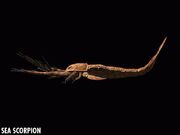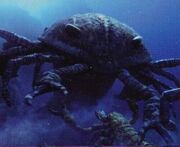Template:Dinoseries

The subphylum (or phylum) Chelicerata (/kəˌlɪsəˈreɪtə/ or /kəˌlɪsəˈrɑːtə/; New Latin, from French chélicère, from chél-; claw, chela + -cère from the Greek keras, meaning "horn") constitutes one of the major subdivisions of the phylum (or superphylum) Arthropoda, and includes horseshoe crabs, scorpions, spiders, mites, harvestmen, ticks, and Solifugae.
Facts
The chelicerata originated as marine animals, possibly in the Cambrian period, but the first confirmed chelicerate fossils, eurypterids, date from 445 MYA in the Late Ordovician period. The surviving marine species include the four species of xiphosurans (horseshoe crabs), and possibly the 1,300 species of pycnogonids (sea spiders), if the latter are chelicerates. On the other hand, there are over 77,000 well-identified species of air-breathing chelicerates, and there may be about 500,000 unidentified species.
In Walking with... Series
Walking with Dinosaurs
Cruel Sea
This episode featured horseshoe crabs, 'living fossils' of the modern age. Consequently, rather than puppets or computer graphics, these animals were filmed live, as they came ashore to mate and lay their eggs, safe from aquatic predators, but vulnerable to creatures such as Rhamphorhynchus (back in the Jurassic). One month later the eggs of the horseshoe crabs hatched and the larvae returned to the sea.
Sea Monsters
Sea Monsters, Episode 1
This episode featured Megalograptus, one of the oldest sea scorpions. At 1 m in length, it was a giant among sea scorpions, but it was still prey to the true master of the Ordovician oceans - the giant cephalopod Cameroceras. As a consequence, Megalograptus came ashore to mate, lay eggs and escape the predations of Cameroceras, especially at night, when the mollusk came to the shallower waters, where the sea scorpions lived.
Walking with Monsters
Water Dwellers
This episode featured Pterygotus, one of the largest arthropods ever, reaching almost 3 m in length. It was one of the top predators of the Silurian sea, lying on the sea bottom in ambush for smaller animals, like Cephalaspis or Brontoscorpio to come close and be seized and eaten. When Pterygotus died out 410 MYA, the sea scorpions never again recovered their former glory. (And 270 MYA they died-out altogether.)

